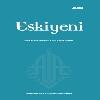Ürdün’de İletişimsel Suskunluğun Biçim ve İşlevleri
Susma, iletişimsel susma, susma ve kültür, süsma ve nezaket
Forms and Functions of Communicative Silence in Jordan
___
- Bruneau, J.J. (1973) Communicative Silences: Forms and Functions, Journal of Communication, 32 (1), pp.17-46.
- Brown, P. and S. Levinson (1987) Politeness: Some Universals in Language Usage, Cambridge :CUP.
- Chomsky, N. (1957) Syntactic Structure, The Hague: Mouton and co.
- Chomsky, N (1979) On Cognitive Structure and Development: A Reply to Piaget, Massioni Palmarini (ed.), Language and Learning, pp. 35-52.
- Davanizhad, K. (2009) Cross-Cultural Communication and Translation, Translation Journal, 13 (4), pp.1-10.
- Ephratt , Michal (2008) The Function of Silence, Journal of Pragmatics, 40, pp. 1909-1938.
- Erkman, P. (1976) Movements with Precise Meanings, Journal of Communication, 26, pp. 14-16.
- Erton,I.(2006) Semiotic Nature of Language Teaching Methods in Foreign language Learning and Teaching, Journal of Language and Linguistic Studies, vol.2,No1 pp.73-86.
- Jacobson, R.(1974) Main Trends in the Science of Language, New York: Harper.
- Jawrski, Adam (1993) The Power of Silence: Social and Pragmatic Perspectives, Sage Publications, Newbury Park, CA.
- Khalil, Aziz M: A Contrastive Grammar of English and Arabic, The Jordan Book Center, Amman, 2010.
- Kristeva, J. (1986) The Kristeva Reader, Oxford: Basil Blackwell Ltd.
- Lebra, T. (1987) The Cultural Significance of Silence in Japanese Communication, Multilingual 6 (4): 343-57.
- Miller, Roy (1982) Japan Modern Myth,: The Language and Beyond, Tokyo: John Wetherill Inc.
- Nankane, L. (2003) Silence in Japanese – Australian Classroom Interaction: Receptions and Performance, University of Sydney, Sydney.
- Saussure, Ferdinand de (1913) Course in General Linguistics, London: Fontana
- Sert, Olcay (2006) Semiotic Approach and its Contribution to English Language Learning and Teaching, Hacettepe Universitesi Eğitim Fakültesi, Dergisi, 31, pp 106-114.
- Sultan, Sabbar S.(2007) Silence and its Discontents in Literature, Darasat, 34 (3).
- ISSN: 1306-6218
- Yayın Aralığı: 4
- Başlangıç: 2006
- Yayıncı: Anadolu İlahiyat Akademisi
Kur’an Deyimlerinin Semantik Analizi
Kur’an’a İlişkin Bilimsel Açıklama Girişimlerinin Doğurduğu Sorunlar
ESKİYENİ Anadolu İlahiyat Akademisi Araştırma Dergisi, Sayı 27 (Kuran ve Sosyal Bilimler II)
Ürdün’de İletişimsel Suskunluğun Biçim ve İşlevleri
“Kur’an’ı Anlama” Sorunu Üzerine Bazı Düşünceler
Kur’an’ın Tedrici Nüzûl Süreci Bağlamında Mekki ve Medeni Ayetler Üzerine
